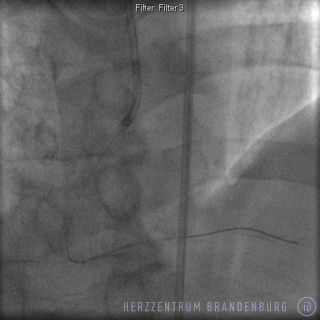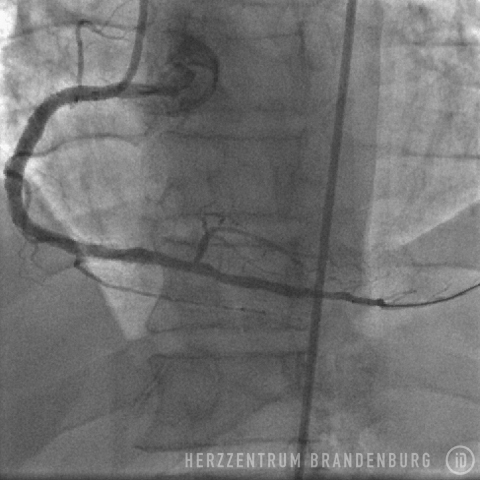
Thrombectomy for heart attack
Heart attacks usually develop as a result of coronary artery disease. If changes to a blood vessel lead to dissection, i.e. a tear in the inner wall of the vessel, platelet aggregation (clotting) is activated, which leads to the vessel becoming blocked. Thrombectomy is a catheter-based procedure that involves the aspiration of these blood clots.
Contact
What is thrombectomy?
The term thrombectomy refers to a procedure to remove a blood clot (thrombus). For patients with heart attack, the invasiveness of the procedure has been reduced to such an extent that only a small incision has to be made in a blood vessel in order to advance the specialist instruments required all the way to the heart. Aspiration of the blood clots is then performed either immediately or, in the case of larger blood clots, once the clot has been broken down into smaller fragments.
Thrombectomy has improved both the safety and effectiveness of treatment for heart attack and, as a result, forms part of routine clinical practice at our Center.
Development of thrombectomy
A heart attack develops when the amount of oxygen supplied to the heart is less than the amount needed by the heart. As early as 1912, a physician named Herrick discovered that myocardial infarction (heart attack) is caused by coronary artery thrombosis. Thrombosis is usually associated with dissection (a tear in the inner wall) of the affected artery, which occurs as a result of pre-existing vascular disease. Dissection leads to the activation of platelet aggregation, and results in clot (thrombus) formation. When a temporary or prolonged occlusion of the vessel leads to an insufficient amount of blood and oxygen reaching the relevant section of the heart muscle, a heart attack occurs.
The fact that blood clots play such a significant role in the development of heart attacks has been known for a long time. As a result, ever since the advent of appropriate drug-treatment in the 1980s, antiplatelet therapy and thrombolytic therapy have formed an integral part of the treatment for acute heart attack. Recanalization of the coronary arteries is a superior treatment strategy when compared to purely drug-based therapy, a fact that has been known since the mid-1990s, and has led to the introduction of 24-hour emergency care for patients with acute heart attack.
In spite of the range of treatment options available, large blood clots forming inside a coronary artery during a heart attack still pose a major problem. During PCTA (percutaneous transluminal coronary angioplasty), wires, balloons and stents all have to cross the blood clot, a process that can lead to pieces of the clot breaking off and blocking the smaller branches of the blood vessel. This can lead to a situation where blockages in the microvasculature prevent normal blood flow from being restored, in spite of the fact that the blood vessel initially blocked has been successfully re-opened.
Medical device manufacturers have since developed tiny catheters and tools for breaking down blood clots, making it possible for at least part of a blood clot to be removed from a blood vessel using thrombus aspiration. At our Center, this procedure has formed part of routine clinical practice ever since Svilaas et al. were able to show that thrombus aspiration is beneficial in patients with acute heart attack.
What conditions are treated with this procedure?
- ST segment elevation myocardial infarction (STEMI)
- non-ST segment elevation myocardial infarction (NSTEMI)
- Recanalization of chronic thrombotic occlusion
What happens during the procedure and what can it achieve?
Thrombectomy is performed in order to reduce the extent of clotted blood found inside a blood vessel. The procedure is important because the manipulation of the inside of a blocked vessel with wires, balloons and stents is associated with the risk of pieces of the thrombus breaking off and causing occlusion in the microvasculature (the capillaries). Successfully reducing the amount of clotted blood inside a vessel leads to a reduction in the risks associated with treatment, and improves its outcomes.
The procedure itself follows the typical steps involved in PTCA. In 95% of all cases involving cardiac catheterization in patients with acute myocardial infarction, we perform the procedure via an entry site in the wrist. This strategy is associated with a lower risk of bleeding, as well as being associated with improved survival in a large number of patients.

Using standard techniques, a catheter is advanced to the point where one of the coronary arteries arises from the aorta. Once the catheter, which is used to move past the occlusion or visible thrombus, is in position, a guide wire is pushed out of the end of the catheter. The wire is then advanced into the peripheral section of the blood vessel, as this ensures a more stable connection between the catheter and the coronary artery.
The process of removing a blood clot from a coronary artery can generally be performed using one of two very different techniques.
- If the blood clot is very large, we perform thrombus removal using a mechanical thrombectomy catheter (ThromCat by Spectranetics). Large clots are broken up into smaller pieces before being safely removed.
- If the blood clot is not very large, we will use tiny catheters by a number of different manufacturers, which allow the aspiration of blood clots via an additional tube. If catheterization reveals blood clots, treatment does not merely involve removal by aspiration. In addition to clot removal, the patient is usually also treated with highly effective anticoagulant medication.
Once the entire clot - or at least the majority of it - has been removed, the patient is then treated with balloon catheters and stents as per standard treatment procedures.
Treatment step-by-step
- Following the application of a local anesthetic, a tiny incision is made in the artery.
- A guide wire is used to introduce a sheath into the artery.
- A catheter is introduced and advanced to the coronary artery.
- The guide wire is used to cross the stenosis or occlusion.
- The blood clot is broken up into pieces and/or removed using aspiration.
- The aspirator is removed.
- The affected section is treated using a balloon catheter and/or a stent.
- Balloon and catheter are removed. A pressure bandage may be applied to the entry site, or it may be closed using a wound closure system.
- The patient is moved to an observation ward.


Further information
Up-to-date information on diseases of the heart and treatment options
Deutsche Herzstiftung (German Heart Foundation)
herzstiftung.de
Deutsche Gesellschaft für Kardiologie
dgk.org
Patientenfassung der Versorgungsleitlinie [Patient version of the treatment guidelines]
versorgungsleitlinien.de
Suggested reading
Zu Therapieformen
Sobieraj DM, White CM, Kluger J et al. Systematic review: comparative effectiveness of adjunctive devices in patients with ST-segment elevation myocardial infarction undergoing percutaneous coronary intervention of native vessels. BMC Cardiovasc Disord. 2011; 11: 74.
Sources
- Peterson KL, Nicod P (Hrsg.): Cardiac Catheterization. Methods, Diagnosis, and Therapy. 1st ed. Saunders. Philadelphia, Toronto, Montreal, Sydney, Tokyo. 1997.
- Topol EJ (Hrsg): Textbook of Interventional Cardiology. 5th ed. Saunders, Elsevier. Philadelphia 2008.
- Krakau I: Das Herzkatheterbuch. Thieme Stutgart, New York 1999.
- Julian D, Braunwald E (Hrsg): Management of acute myocardial infarction. Saunders. London, Philadelphia, Toronto, Marrickville, Tokyo 1994.
- Svilaas T., Vlaar P.J., van der Horst I.C., et al. N Engl J Med 2008;358:557-56.
